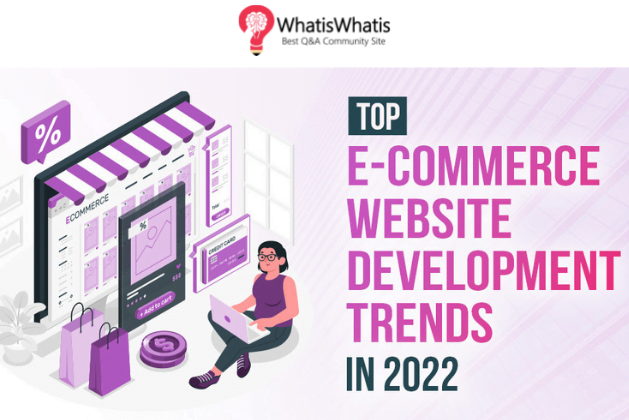IT in e-commerce plays a crucial role in day-to-day projects and performance of businesses, from an online store perspective or while reaching out to customers. Information technology improves customer experience, transactions, and streamlines administrative processes in e-commerce development.
E-commerce is now widely used by people of all ages. E-commerce is expected to become a $5.55 trillion market in 2022, as per stats by eMarketer. We can have almost anything delivered to our homes, including books, clothing, and groceries. It takes only a click on a desktop computer or smartphone and receive the order in a few hours or less than a day or two.
So how are the new emerging technologies supporting organizations and their employees? E-commerce has leveled the playing field for firms that have direct-to-consumer business strategies as they provide a fantastic online experience. Even organizations that were formed in an omnichannel world must stay one step ahead by implementing new ecommerce trends and avoid being overtaken by more agile competitors.
Here is a list of new trends in the ecommerce industry that can help your business reach new peak when you get a chance to hire talented eCommerce developers:
What Are The List of E-Commerce Web Development Trends in 2022?
1. Artificial Intelligence
Artificial intelligence is changing retail business by predicting client buying behaviors based on what they buy and when they buy it. If online buyers buy a certain brand of rice every week, the online merchant could give them a customized offer for that product, or even make a recommendation for an accompanying product.
Example – Consider Amazon‘s virtual assistant, Alexa. Alexa has become one of the most popular AI voice assistants in the eCommerce industry. Customers can use Alexa voice to identify nearby venues, book a vehicle, and even order food from Domino’s.
2. Chatbots in E-Commerce Web Development Trends
Brands have begun to use AI and automation to improve the customer experience as machine learning technology grows more sophisticated. Chatbots software can communicate with customers via a live chat interface. Chatbots give real-time customer assistance 24 hours a day, seven days a week, and can be used to direct customers to the appropriate sites and keep them coming back to your store.
Read More: How Does Chatbot Software Can Automate Your Work?
Example – H&M created a chatbot from Kik. The bot, which acts as a virtual stylist, gives each user personalized wardrobe ideas. It’s a great example of how to use a chatbot to personalize an online client experience.
3. Live shopping
Live shopping keeps viewers interested and creates a connection with the audience by providing an immersive shopping experience. It is an experience similar to in-person purchasing but with the extra convenience of customers being in their own homes. Brands may differentiate themselves from competition online by removing many of the obstacles that exist between customers and brands when purchasing online.
Know more: Reasons Why Branding Is a Must For Every Business
Livestream from a favorite brand is an excellent approach to providing product instruction to viewers. Showing apparel on a model or answering inquiries, as well as providing unique discounts, product recommendations, and reviews, are just a few examples.
Example – Sephora has been selling products via live events utilizing Facebook’s new functionality. In a live instruction, the beauty business was able to display a variety of cosmetics.
4. AR and VR
The usage of augmented reality (AR) and virtual reality (VR) to make the shopping experience even more immersive is expected to arise as technology continues to evolve at such a rapid rate. Shoppers may eventually be able to conduct virtual face-to-face interactions with brands, just like they would if they were in a store.
The most important, yet often overlooked, thing marketers can do is develop a mobile-friendly ecommerce website by using a responsive design, improving product display, and making the checkout process simpler.
Example – IKEA was one of the first companies to use augmented reality in ecommerce. It released the IKEA Put app in 2017, which allows customers to place thousands of items in their houses with 98 percent accuracy.
5. Mobile Commerce for eCommerce
Best E-commerce platforms like Shopify or BigCommerce offer a variety of mobile integrations and features such as mobile-responsive themes, one-click checkout, and a mobile app – to support the best shopping experience for clients.
Another factor that can make a good contribution to shopping experience is the 24/7 customer service. As time is money, businesses strive to provide customers with a more efficient and easy purchasing experience.
The main benefit and one of the driving causes behind the expansion of mobile commerce is the ability to provide speedier transactions to your clients. Shopping applications on smartphones have a faster processing speed than regular websites. Check our case study on how our developers helped a client to upgrade their old digital space with new mobile apps.
Example – Using the Starbucks Card Mobile App, iPhone users can pay for coffee at more than 1,000 Starbucks locations without pulling out wallets or digging through purses.
6. Multi-Channel in E-Commerce Web Development Trends
Multi-channel enables you to expand brand awareness, increase sales, and enhance the customer experience through practicality and convenience.
However, managing multiple sales channels can be challenging. But the continued success of multi-channel and its benefits clearly outweigh the challenges.
Example – Bank of America has raised the bar when it comes to multi-channel marketing. The company offers account management functionality through its numerous channels and customer touchpoints. Almost everything may be done on the website, via the mobile app, or in a real place, from booking appointments to depositing checks.
7. Machine Learning and Analytics
Machine learning is a branch of AI that includes many other technologies. It entails the development of algorithms or programmers capable of accessing and learning from data without the need for human programming.
Pattern recognition is an algorithm that ‘learns.’ The algorithm is trained by feeding data. It then examines and identifies inclinations. The algorithm eventually becomes ‘intelligent,’ allowing it to apply what it has learned to new data sets.
Difficult times serve as catalysts for advancement. This once-in-a-generation transformation will have a significant impact on our lives, emphasizing the relevance of ecommerce even further.
Companies that wish to benefit from rising traffic and online sales while also preparing for the new normal must comprehend data and use ecommerce analytics.
Example – Amazon has one of the most famous recommendations engines of any ecommerce retailer, and for good reason; their machine learning algorithms work so well that 55% of sales are driven by these machine learning recommendations.
8. Digital Transaction in E-Commerce Web Development Trends
Difficult times serve as catalysts for advancement. This once-in-a-generation transformation will have a significant impact on our lives, emphasizing the relevance of ecommerce even further.
Companies that wish to benefit from rising traffic and online sales while also preparing for the new normal must comprehend data and use ecommerce analytics.
Covid-19 has unquestionably increased ecommerce transactions, and consumers are anticipating a long-term shift. The adoption of new payment methods has been fueled by factors such as convenience, increased trust, ease of use, easy returns, acceptance, and incentives, among others. In the long run, these factors will most likely continue to influence consumer behavior.
Example – When you log into your Amazon and purchase a book, this is a classic example of an e-commerce transaction. Here you interact with the seller (Amazon), exchange data in form of pictures, text, address for delivery etc. and then you make the payment.
9. Inventory Management
Inventory management is useful to your operational efficiency and longevity in any goods-based business because of the relevance of inventory in any goods-based business.
Without a wise approach, you’ll face an army of obstacles, including blown-out costs, lost revenues, bad customer service, and even outright failure, whether you’re an SMB or a company that already uses enterprise resource planning (ERP).
Example – Walmart employs cutting-edge technology to track inventory and replenish shelves, allowing the retailer to save money. The objective is to reduce disturbances and streamline process in the supply chain, share information with suppliers, and link purchases to sales more directly. Inventory management software, which allows for automated reordering, cross docking, and other inventory tactics, is the technical backbone of Walmart’s supply chain innovation.
Also Know: How to Become a Successful Entrepreneur and Business Owner?
Conclusion
As the leading provider of software solutions, our developers from Clarion can help you design ecommerce portals customized for your specific requirements. Your business needs a change to transform your vision into reality. Focus on the e-commerce trends that matter—like optimizing the customer journey and planning for future growth by partnering with us.






Leave a comment